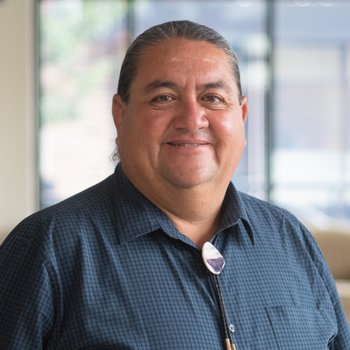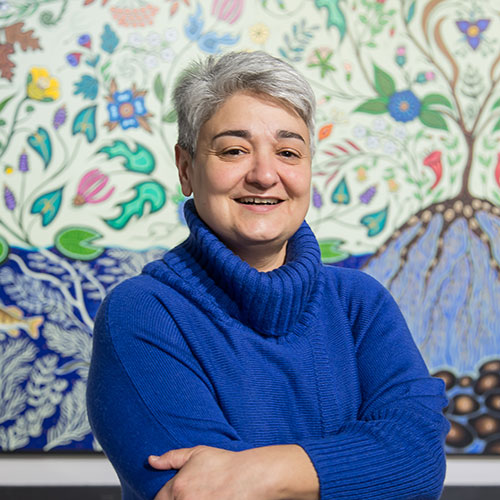Search for academic programs, residence, tours and events and more.


Ojibwe artist Mike Cywink’s woodland-style mural One Heart, One Mind, One Vision (2023) stands 40 feet high on the southwest wall of Wilfrid Laurier University’s Waterloo campus library.
The mural is a testament to Laurier’s commitment to Indigeneity, truth and reconciliation and a celebration of Indigenous cultural expression, storytelling, and ways of knowing. One Heart, One Mind, One Vision serves as a reminder of the enduring strength and resilience of Indigenous peoples and an invitation for all of us to engage in meaningful dialogue and understanding. It reinforces our collective responsibility to create an academic community where diverse voices are heard, valued and cherished.

“This public artwork reminds us that Laurier shares its campus with Indigenous Nations that existed on these lands since time immemorial – and that Indigenous Peoples are welcomed to learn, work, and teach here.”
Darren Thomas, AVP Indigenous Initiatives
One Heart. One Mind. One Vision is rich in symbolism. Here are some of the themes and teachings represented in it.
Indigenous peoples use medicine wheels to mark significant locations; its place on the mural marks Laurier as a place of teaching and learning. The wheel depicts harmony and balance, with its four parts representing the four seasons and four directions.
The seven pink orbs represent the seven grandfather teachings: humility, courage, respect, love, honesty, truth and wisdom – all gifts we should walk with.
The eagle is looking out over the people, the one who flies closest to the creator and carries our prayers and positivity with him.
The Dish with One Spoon Wampum commemorates the relationship between the Anishnaabek and Haudenosaunee. The Dish with One Spoon is a metaphor of the land as one dish to be shared, with everyone benefiting from its sustenance.
The two teepees represent home: your original home where you come from, and Laurier, the place that is your home for a portion of your journey. The fire brings warmth and safety. More than an educational institution, Laurier is a home – a community where we learn, live, work, grow, and belong.
For some indigenous peoples, Turtle Island refers to the continent of North America.
The Haldimand proclamation of 1784 granted the Haudenosaunee people a tract of land 10 km deep on either side of the Grand River, beginning at its source to Lake Erie. This area provided the basis of the Six Nations reserve and includes the land on which Laurier’s Waterloo and Brantford campuses are located.
The trees and bear cubs represent seven generations. Indigenous teachings tell us we must think seven generations ahead through our actions, words, and way of being. The elder and youth are sharing medicines with the cubs. This symbolizes the passing on of knowledge and learning, the heart of Laurier’s mission.
The roots represent the resiliency of Indigenous peoples, who have persevered through decades of attempted assimilation.


“The mural stands not only as a wonderful work of art but also as a powerful symbol of the values we hold dear: respect, unity, and a shared commitment to a more inclusive future.”
Gohar Ashoughian, University Librarian (2012-2023)

Conceived as a powerful form of artistic expression, the mural acknowledges and pays homage to Indigenous peoples' profound historical ties and connection to the land upon which Laurier stands.
Throughout the summer of 2023, artist Mike Cywink spearheaded engagement and painting sessions, rallying over 120 community members to join hands in crafting this monumental mural.

The mural is a collaboration between the Wilfrid Laurier University Library, Robert Langen Art Gallery, and Laurier’s Office of Indigenous Initiatives that reflects Laurier’s commitment to reconciliation, decolonization, and Indigenization.

"All sorts of people came to the community painting sessions – high school, college and university students; faculty members; families living in the community; and Indigenous community members. Whenever I walk past, I’m reminded of the importance of community, and how special the one here at Laurier truly is."
Charlotte Knight, Laurier student